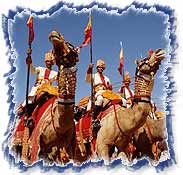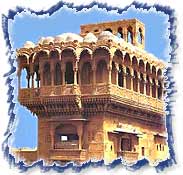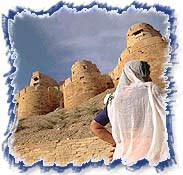Jaisalmer

Introduction :
The city of Jaisalmer shimmers like a mirage amidst the desolate beauty of
the hot barren deserts of Rajasthan. It is a small city that can be covered
within two hours of leisurely strolling through the lanes and by-lanes, and
has an extraordinarily medieval feel and incredible atmosphere. The havelis
(mansions of rich merchants) which are the pride of Jaisalmer’s
architecture and a part of the national heritage should be seen and admired
at an unhurried pace. The Jaisalmer Fort, perched atop the triangular-shaped
Trikuta Hills, contains some gems of Jain temple buildings, while
beautifully decorated havelis are scattered throughout the town. The city is
also famous for its beautiful embroidery.
During the medieval times Jaisalmer made rapid progress due to its
strategic location on the camel trade route between India and Central Asia.
Even now, especially after the two wars with Pakistan, its strategic
importance has led to the building of national highways, a railway track,
and an airstrip, and brought Jaisalmer within easy reach of the people.
The climate of this city is of typical desert character. Temperatures range
between 46°C and 35.4°C in the summers, and 14°C and 2°C
in the winters. The best season to visit is between October and March,
especially between January and February when Jaisalmer becomes a hub of
tourist activities during the desert festival.
Tourist Attractions in Jaisalmer :
Jaisalmer has a large number of tourist sites of unsurpassed architectural
wealth.
 »
Jaisalmer Fort-
»
Jaisalmer Fort- The
Jaisalmer Fort is the second oldest fort in Rajasthan after Chittaur, and
commands the desertscape from its 250 feet high pedestal on the Trikuta
Hill. Three strong walls protect the citadel. The fort has five palaces
called Sarvottam Vilas, Akhai Vilas, Gaj Mahal, Rang Mahal and Moti Mahal.
Jali or latticework screens of excellent craftsmanship shade interiors from
the fierce heat and desert winds. The Rang Mahal has some exquisite murals
painted on arches and spandrels. The fort contains one-third of the city’s
population. Many houses provide budget accommodation to visitors and have
curio shops.
» The Jain Temples - Three exquisitely sculptured
Jain temples dedicated to Rishabhdevji, Sambhavanathji and the Ashthapadi
temple are located within the fort. Their ornamentation, done in the style
of the Dilwara temples at Mt. Abu, is marvellous. The emerald icon of
Mahavira here is an unparalleled gem.
» Salim-Singh-ki-Haveli - The Salim-Singh-ki-Haveli
is a magnificent edifice whose two upper storeys had to be demolished and
yet whose surviving structure has unsurpassed splendor. Particularly
noteworthy are the rows of peacocks below the jharokhas (projected arched
balconies).
» Patwon-ki-Haveli - Near the city centre is
the Patwon-ki-Haveli. Its five suites built between AD 1800 and AD 1860 are
evidence of Jaisalmer’s legendary architectural wealth. The balconies
are delicately chiseled, and oblique sunrays create enchanting and dramatic
shadows. It is the grandest mansion in Jaisalmer, a veritable museum piece
in the open.
» Nathmal-ki-Haveli - This haveli has two
identical-looking portions, which are, in fact, two different parts united
by a common façade. The projected balconies or jharokhas are a
perfect example of jeweler’s art applied to stone carving.
» Desert Culture Centre and Museum - The Desert
Culture Centre and Museum has a number of old coins, different kinds of
textiles, traditional Rajasthani instruments, and some fossils that were
discovered in the desert. It gives a visitor an insight into the history of
Rajasthan.
Excursions in Jaisalmer :

There
are plenty of excursion sites of varied character near Jaisalmer.
» Lodurva - Lodurva, the ancient capital of the
Bhattis, is 16 km from Jaisalmer. Its ruins are visited for the great Jain
temple and the Kalpataru, a mythical tree of wish fulfilment. Lodurva has a
great number of peacocks that hover around the temple walls lending
spectacular colour to the dry and stony landscape. Amar Sagar is a grand
artificial reservoir for water with a temple and a promenade on the bank
that is a lovely place for a picnic.
» Akal Wood Fossil Park - The Akal Wood Fossil Park
is a 21-hectare preserved area that takes you back to the Jurassic period
when the whole Thar region lay under the sea. Fossilized logs of trees
trunks lie exposed to view. Innumerable trunks lie buried deep under sand,
25 are seen and 15 are above the ground. The largest log is seven meters in
length and 1.5 meters in width.
The ghost village of Kuldhara, the Sam Sand Dunes and the Desert National
Park are the other places that must be visited.
How to Reach Jaisalmer :

Jaisalmer
is 897 km from Delhi; 638 km from Jaipur; 285 km from Jodhpur; 500 km from
Ajmer and 330 km from Bikaner. It is connected by a good road network to
Jodhpur, Bikaner via Pokhran, and Barmer via Devikot. Jaisalmer is a small
city that is best explored on foot. The Jodhpur Airport is the closest
airport that is 308 kms from Jaisalmer. Jaisalmer is linked to Mumbai,
Delhi, Jodhpur, and Jaipur by Alliance Air. The Palace-on-Wheels is the most
luxurious way to travel to Jaisalmer, recreating within the coaches the
ambience of the legendary palace comforts.
Important Travel Information :
Jaisalmer is famous for its embroidery, Rajasthani mirror work, rugs,
blankets, and the finely cut antiques. It is a good place for buying
exquisitely embroidered garments with mirror work in a brilliant mosaic of
colours, traditional rugs, blankets and shawls, silver jewellery, stonework,
carpets made from camel hair, and colourful silk and cotton cloth. The
Desert Festival that is held between January and February is a celebration
of the Rajput heritage, with lots of singing and dancing, cultural
programmes, camel races and other interesting competitions



 »
Jaisalmer Fort- The
Jaisalmer Fort is the second oldest fort in Rajasthan after Chittaur, and
commands the desertscape from its 250 feet high pedestal on the Trikuta
Hill. Three strong walls protect the citadel. The fort has five palaces
called Sarvottam Vilas, Akhai Vilas, Gaj Mahal, Rang Mahal and Moti Mahal.
Jali or latticework screens of excellent craftsmanship shade interiors from
the fierce heat and desert winds. The Rang Mahal has some exquisite murals
painted on arches and spandrels. The fort contains one-third of the city’s
population. Many houses provide budget accommodation to visitors and have
curio shops.
»
Jaisalmer Fort- The
Jaisalmer Fort is the second oldest fort in Rajasthan after Chittaur, and
commands the desertscape from its 250 feet high pedestal on the Trikuta
Hill. Three strong walls protect the citadel. The fort has five palaces
called Sarvottam Vilas, Akhai Vilas, Gaj Mahal, Rang Mahal and Moti Mahal.
Jali or latticework screens of excellent craftsmanship shade interiors from
the fierce heat and desert winds. The Rang Mahal has some exquisite murals
painted on arches and spandrels. The fort contains one-third of the city’s
population. Many houses provide budget accommodation to visitors and have
curio shops. There
are plenty of excursion sites of varied character near Jaisalmer.
There
are plenty of excursion sites of varied character near Jaisalmer. Jaisalmer
is 897 km from Delhi; 638 km from Jaipur; 285 km from Jodhpur; 500 km from
Ajmer and 330 km from Bikaner. It is connected by a good road network to
Jodhpur, Bikaner via Pokhran, and Barmer via Devikot. Jaisalmer is a small
city that is best explored on foot. The Jodhpur Airport is the closest
airport that is 308 kms from Jaisalmer. Jaisalmer is linked to Mumbai,
Delhi, Jodhpur, and Jaipur by Alliance Air. The Palace-on-Wheels is the most
luxurious way to travel to Jaisalmer, recreating within the coaches the
ambience of the legendary palace comforts.
Jaisalmer
is 897 km from Delhi; 638 km from Jaipur; 285 km from Jodhpur; 500 km from
Ajmer and 330 km from Bikaner. It is connected by a good road network to
Jodhpur, Bikaner via Pokhran, and Barmer via Devikot. Jaisalmer is a small
city that is best explored on foot. The Jodhpur Airport is the closest
airport that is 308 kms from Jaisalmer. Jaisalmer is linked to Mumbai,
Delhi, Jodhpur, and Jaipur by Alliance Air. The Palace-on-Wheels is the most
luxurious way to travel to Jaisalmer, recreating within the coaches the
ambience of the legendary palace comforts. 